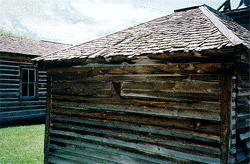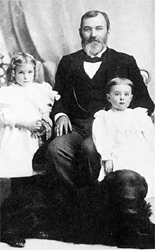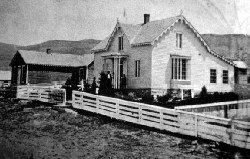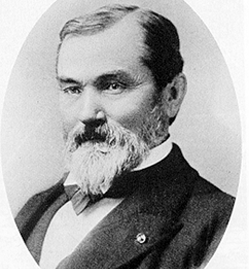Wilbur Fisk Sanders House
Updated: August 24, 2020

Virginia City, a boomtown of the early gold-rush era of Montana, lives on today while many similar mining camps have disappeared. Agriculture, county government, and tourism have long since replaced mining.
In 1863 the great Montana gold-rush began, and the strike in Alder Gulch became one of the most memorable episodes in Western mining history. The major camp established in Alder Gulch was Virginia City; it became the center for mining activities. Probably her period of greatest significance relative to mining was a ten-year period from 1865 to 1875. During this time it is estimated that the surrounding area yielded $70,000,000 in gold and that Alder Gulch area had a population that fluctuated up to 10,000 people--a number far greater than the inhabitants of most towns of Montana today. However, her population dwindled rapidly as miners seeking their fortunes left the site of one gold strike to chase rumors of another. Virginia City's population dipped to 149 in 1970, but the town would not die.

Montana Historical Society Photograph
Archives. Material may be protected
by copyright law (Title 17 U.S. Code).
A party of six men is credited with the discovery of gold in Alder Gulch on May 26, 1863. Early in the morning of May 28, they staked out claims and left that day for Bannack for supplies. The news leaked out, and Alder Gulch came alive with camps and towns. Some of the settlements were Centerville, Nevada City, Adobetown, Junction, Ruby, and Central City, in addition to Virginia City.
The area became a hustling metropolis almost instantly, with all the problems associated with many people and few laws to protect the individual. Road agents, murderers, thieves and highwaymen were on the scene almost as quickly as the miners. These camp followers caused immediate problems for Virginia City and Alder Gulch but efforts to form a government and establish law and order moved rapidly, though not exactly hand-in-hand.
Montana was then part of Idaho Territory. Sidney Edgerton was appointed Chief Justice of the Territory of Idaho and was assigned the third district, which roughly comprised what soon became Montana. In June, 1863, he and his family--accompanied by his nephew, Wilbur Fisk Sanders, and the Sanders family left Akron, Ohio, for Idaho Territory. Reaching Bannack, the largest town in his district, in September, the party settled for the winter. Edgerton was quickly convinced of the need to create a new territory and started back for Washington in January, 1864, where he helped persuade Congress to create the Territory of Montana, which it did by a vote on May 24, 1864. Abraham Lincoln named Sidney Edgerton the first Governor of the new Territory.
But Edgerton's nephew, Col. Wilbur F. Sanders, also made his impact on Montana's history. Sanders was an ambitious and courageous young attorney. The trial of the first of the notorious road agents and murderers, George Ives, was held in Virginia City on December 21, 1863. Colonel Sanders was in town at the time and was appointed prosecuting attorney by the miners' court. He successfully prosecuted Ives and obtained a conviction although threats of reprisal by Ives' friends were spoken freely. After the conviction, it was Sanders' motion that the sentence be carried out immediately, rather than waiting until the next day, even though darkness had fallen. Ives was taken to a partially completed house selected for the site of execution and hanged that same evening. The famed quote, "Men do your duty," is attributed to Sanders.

Society Photograph Archives. Material may be protected
by copyright law (Title 17 U.S. Code).
Wilbur F. Sanders made many other contributions to the State of Montana during his lifetime. He was corresponding secretary to the Society of Montana Pioneers when it was formed December 11, 1864; was elected first chairman of the Montana Bar Association when it was organized in January, 1865; and when the formation of the Montana Historical Society was authorized on February 25, 1865, he was elected president pro tem. He held that office until February 1, 1890, a period of twenty-five years. The Republicans of both houses of the newly formed State of Montana legislature elected him U. S. Senator on December 31, 1889. At that time senators were selected by the state legislature. In Montana the Democrats and Republicans split into two groups that year, each selecting a set of senators, but the election of Sanders and his running mate, T. C. Power, was upheld by the U. S. Congress. Colonel Sanders died on July 7, 1905.
The accomplishments add to the importance of the house Sanders built for himself and his family. Their first home was in Bannack, but later they moved to Virginia City. An entry in Mrs. Sanders' diary dated July 14, 1867, reveals that she had slept for the first time in their new home on Idaho Street. They remained in Virginia City until the 1870's, when the Sanders family moved to Helena. Their new three-story home was built in 1875.

Photograph Archives. Material may be protected by
copyright law (Title 17 U.S. Code).
The Sanders home in Virginia City is a story-and-a-half frame cottage located on a hillside acre on Idaho Street, one block above (south) of Wallace Street. The building is on the south side of the street and faces north-northwest. The building has steep gabled roofs of varying heights and a hip roof (over a later addition) on the east. Apparently several additions have been made over the years. Roof covering varies from wood shingles on the rear portion of the building to asphalt shingles on the front section. Numerous brick chimneys project from the steep pitches of the various roof planes. The building rests on a foundation of native fieldstone. A distinct feature of the simple, well-composed building is the one-story wood porch that protects almost the entire front. Noteworthy are the "open" wood columns and the ornate wood brackets that support the porch eaves and the porch beam. Simpler brackets support the eave of the bay window in the west side of the front living room. There are four columns across the front porch and two columns, one at each end of the porch, adjacent to the wall of the house.
A comparison of photographs of the front of the building shows several changes made prior to the turn-of-the-century. The porch originally consisted of the central section of the present porch, and at some time it was lengthened. Other obvious changes are ornate bargeboards (woodwork covering the joint between a gable roof and the roofing material) and the carved wood pediment above the gabled windows that are now gone. These gave a Gothic-esque appearance to the house. In early photographs the siding appears to be narrower than today, as well.
The shutters that flank the windows were added at some time, as well. A photograph dated 1899 shows above changes, with full porch, shutters, and no bargeboards. Subsequent changes have been the addition of a picture window on the west, kitchen remodeling, and the small rear entry that was probably originally a porch. The west side of the building has a bay window and farther to the south a covered porch protects a side entry. The original windows are basically wood double-hung units with 4/4 lights. Interior (and original exterior) doors are paneled and framed by ornate moldings. Of special interest is the decorative cast hardware revealed in the door hinges, knobs, escutcheon plates, and in the window latches.
The building has had relatively few owners. When the 1899 photograph was taken, the building was owned and occupied by A. W. Hall. Later it was owned by Jones Duncan and finally by James Vanderbeck who purchased the home in 1940. He has maintained the building well; it is in remarkably fine condition.
Colonel Sanders gained national prominence as a Vigilante, lawyer, legislator, businessman and politician. His mark on the history of Virginia City remains in this fine home.
Special acknowledgements to: John D. Ellingsen, John N. DeHaas, Tony Dalich, and Ken Sievert Tom Cook and Ellen Baumler of the Montana Historical Society.
Updated: August 24, 2020

